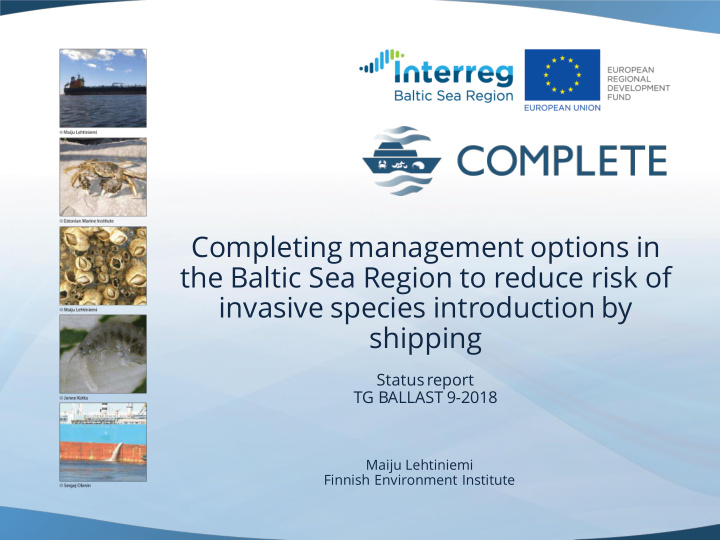



Completing management options in the Baltic Sea Region to reduce risk of invasive species introduction by shipping Status report TG BALLAST 9-2018 Maiju Lehtiniemi Finnish Environment Institute
COMPLETE project 12 partners • 23 associated organizations • 10/2017 – 09/2020 • Harmonization of monitoring for • NIS/HAOPs (MSFD/BWMC synergies) Regionally harmonized implementation • and enforcement of IMO BWMC Roadmap proposal for a regional • biofouling management strategy Stakeholder involvement and participation •
COMPLETE project Homepage: www.balticcomplete.com Twitter: @BalticCOMPLETE #BalticCOMPLETE
Developing molecu cular methods for NIS detect ction → Selection of first candidate species for the detection by eDNA methods Biofouling asse sessm ssment protoco col for leisu sure boats → Preliminary protocol has been developed and tested, WP2 sampling in 2019 Guidelines for Assessm ssment of biofouling potential and areas of risk sk surveillance and monitoring → Data for the calculation of wetted surface area (WSA) of of non- maritime traffic will be collected indigenous → Most vulnerable areas for species introductions will be species identified Integrated monitoring of NIS → Monitoring manual for the BSR will be drafted → Includes all applied monitoring methods including new methods, developed during COMPLETE
Target speci cies s select ction criteria and risk asse sessm ssment → HELCOM/OSPAR JHP target species selection criteria and risk assessment scheme (BWMC A-4) are currently reviewed Advance ced risk sk asse sessm ssment tool under HELC LCOM OM/OS OSPAR JHP HP → Improvement of the online risk assessment tool http://jointbwmexemptions.org/ballast_water_RA/apex/f?p=104:13 → Link between AquaNIS and risk assessment tool http://www.corpi.ku.lt/databases/index.php/aquanis/ WP3 Regionally harmonized early warning syst stem (EWS) Ballast st water → Related to WP2 monitoring programme risk asse ssessm ssment → First steps: defining warning criteria, identification of species of and concern, institutions responsible for NIS detection and warnings management systems Decisi sion support syst stem (DSS) for BSR ballast st water management → BWM DSS derived from VECTORS project will be adapted to BSR → First step: Collection of experiences from BWMC implementation Training of authorities s for the BWMC → Harmonization of ballast water sampling and analysis processes → Organized in spring 2019 in Hamburg or Bremerhaven (April/May) → Invited: Port State Control authorities of all Baltic Sea countries
Biofouling regulations, s, cleaning procedures s and facilities → Information gathered on: National legislation (cleaning and anti- fouling), facilities and waste management. Application and experiences with IMO biofouling guidelines and guidance Best practices for biofouling management within and outside de BSR → Good practices and best available technology (antifouling, WP4 cleaning, biofouling management) → Assessment of applicability in the BSR Evidence ce-base sed options s for biofouling Guidance on antifouling syst stems s (AFS) performance / cost-efficiency management in the Baltic c Sea → Growth of biofouling on different AFS and efficiency of these Region systems, test of the efficiency of different copper concentrations in AF, hull cleaning effects Benefits s of biofouling management on ship speed, fuel consumption and emissi ssions → Measurements on the effect of biofouling management on ship emissions and fuel consumption started
Information syst stem on non-indigenous s speci cies s and harmful aquatic c organism sms s and pathogens → Further development of the AquaNIS information system, which contains the most up-to-date and free-access information/data on NIS Decisi sion support tool for selection of optimal anti-fouling syst stem and WP5 cleaning options Database ses s and → First version of a decision support tool for evaluating biofouling risk user-friendly and its cost-effective management will be developed information → Tool will integrate knowledge related to performance and cost- support efficiency of different anti-fouling strategies Interact ctive user-friendly map on hull cleaning service ces → Presents the hull cleaning services and applied technologies in the Baltic Sea Region
Co Co-ope peration with the stake keholde ders → Stakeholder mapping and analysis ongoing → Once completed, active communication and involvement of all project target groups during the project WP6 Roadmap proposa sal for a harmonized biofouling management strategy in the Baltic c Sea Region Stakeholder involvement → Tailored recommendations from the project for the Baltic and strategy Sea Region, reviewed and supplemented by the target development groups processe sses → Proposal for specific actions needed in order to reach harmonized biofouling management of maritime and leisure traffic → Evaluation which stakeholders have to be involved in developing this regional management strategy
www.balticcomplete.com
Recommend
More recommend